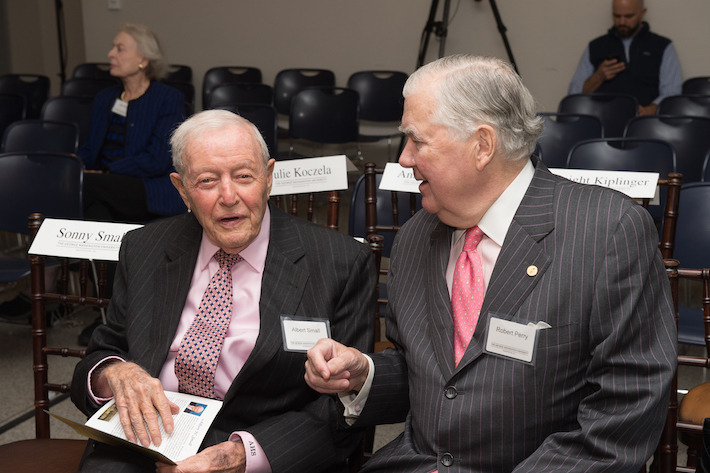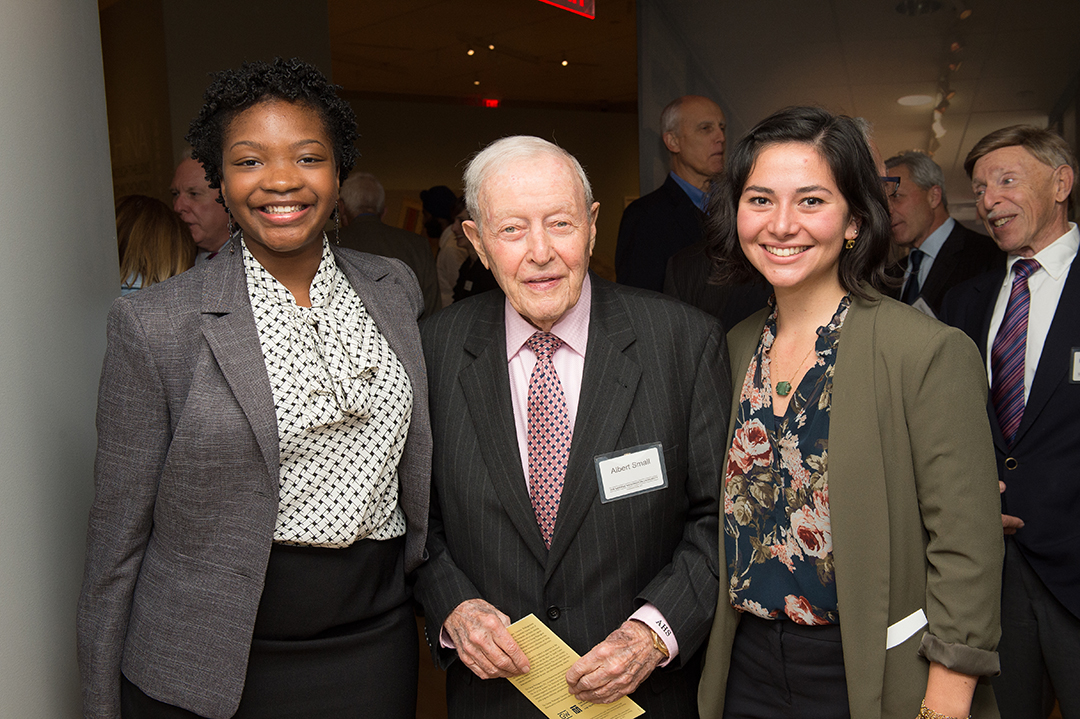Like many people on campus, GW students Anna McGarrigle and Najya Williams had walked by St. Mary’s Episcopal Church on 23rd Street almost every day. Neither of them had thought much about the site—until they unpacked its history of racial tension using the Albert H. Small Washingtoniana Collection.
Ms. McGarrigle, a junior, and Ms. Williams, a senior at School Without Walls completing her second year at GW, used the collection in a class called “Washington, D.C.: History, Culture, Politics.” Associate Professor of History Christopher Klemek requires students to study a part of Foggy Bottom and publish findings on an interactive web exhibit called DigitalDC.
They revealed what they learned about the church at a symposium honoring Albert H. Small on Monday night. Mr. Small donated his unparalleled collection of Washington maps, prints and other ephemera to the George Washington University in 2011. Now, the collection is available to the D.C. community in its permanent home at the George Washington University Museum and The Textile Museum’s Woodhull House.
During their presentation, Ms. McGarrigle and Ms. Williams explained that they looked at maps in the collection from 1850, 1903 and 1921. They learned that inthe early 1900s, many poor African Americans and underprivileged residents lived in alley dwellings behind the church. The alley dwelling communities went through renovations in the mid 1900s, and the revitalizations ignited controversy. Suddenly, whites coveted the rehabilitated areas that African Americans used to occupy.
“I couldn’t wrap my head around the fact that people were fighting for living space in an alley,” Ms. Williams said.
Their hands-on research is exactly what Mr. Small envisioned when he gave his collection to GW. He wanted new generations of scholars to access his trove of historic treasures to learn about the nation’s capital.
“Albert had many choices to place his collection—with Smithsonian, with the Library of Congress, with the Archives. But he chose the president’s university,” said trustee emeritus Robert Perry, B.S. ’70, the chairman and president of the National Trust for the Humanities.

Mr. Perry with Mr. Small.
GW has hosted the annual Small Symposium for the last five years to showcase how students are using the collection for scholarship on Washington. This year marked the first time the event had been held in the new museum, and it also served as a chance to celebrate the opening of two exhibitions in the Woodhull House. One of the shows, “A Collector’s Vision: Creating the Albert H. Small Washingtoniana Collection,” explores Mr. Small’s desire to preserve history and showcases many of the objects in the collection.
“Our symposium celebrates Mr. Small’s generosity,” Museum Director John Wetenhall said in welcoming remarks. “It marks our progress in bringing the riches of the Albert H. Small collection to students, faculty and the general public.”
Hannah Salaoio, M.A. ’15, shared a different way Mr. Small’s gift enhanced her classroom experience. Ms. Salaoio took an exhibit design class with adjunct professor Barbara Brennan, and one of the assignments was to design “A Collector’s Vision: Creating the Albert H. Small Washingtoniana Collection.”
“This was by far the highlight of my master’s program. A lot of grad students do not get the opportunity to work with collectors, with objects and with professional museum staff,” she said.
Consulting curator for the George Washington University Museum Jane Freundel Levey, M.A. '91, shared that Mr. Small’s collection also has strengthened the university’s relationship to Washington.
Scholars from all over the city have come to the museum to see exhibitions featuring Mr. Small’s collection and to study objects firsthand in the Woodhull House’s Albert H. Small Center for National Capital Area Studies. A regular lunchtime lecture also invites D.C. enthusiasts to discuss the city’s history every Monday.
The symposium also featured remarks from James M. Goode, who served as the curator of the Washingtoniana Collection for 22 years. Forrest Maltzman, senior vice provost for academic affairs and planning, and Columbian College Dean Ben Vinson III thanked Mr. Small for his contributions to the university.
“Mr. Small has proven time and time again—through his philanthropy, through his business acumen, through everything that has made him who he is—that one person can indeed make a difference in the lives of students, in the lives of community citizens and in the legacy of this great city,” he said.
Following remarks, guests toured the two new exhibitions in the Woodhull House. They had the opportunity to see “A Collector’s Vision: Creating the Albert H. Small Washingtoniana Collection” as well as “For the Record: The Art of Lily Spandorf,” which highlights the locally known watercolorist who documented Washington’s changing scenes.

Dr. Knapp presents Mr. Small with a gift.
A birthday reception for Mr. Small, who turned 90 last month, followed. George Washington President Steven Knapp and Mr. Perry offered Mr. Small several gifts—the UVA graduate got a GW pillow, a commemorative book chronicling the museum’s construction process and a giant card signed by the symposium’s guests.
Mr. Small ended the evening by thanking guests and sharing the story of the first object he ever collected—a collection of pictures that showed the 26 original boundary stones dividing D.C. and Maryland.
“That’s how I started collecting,” he shared.


